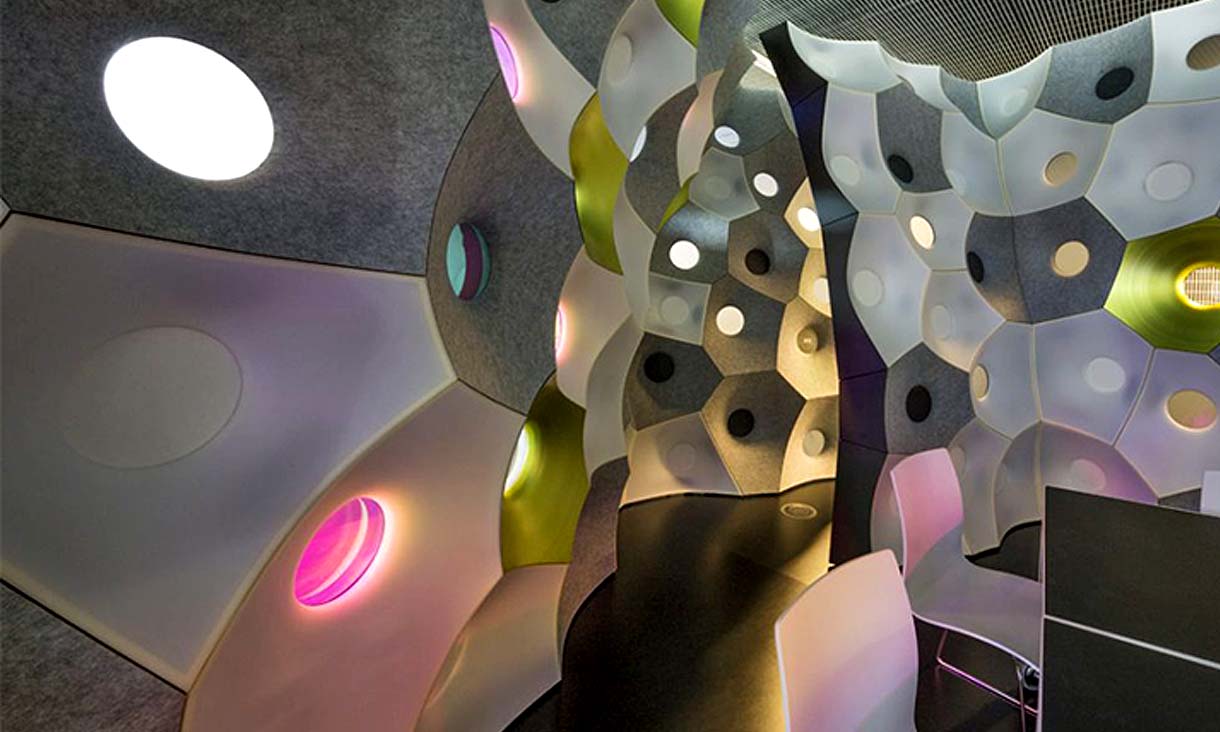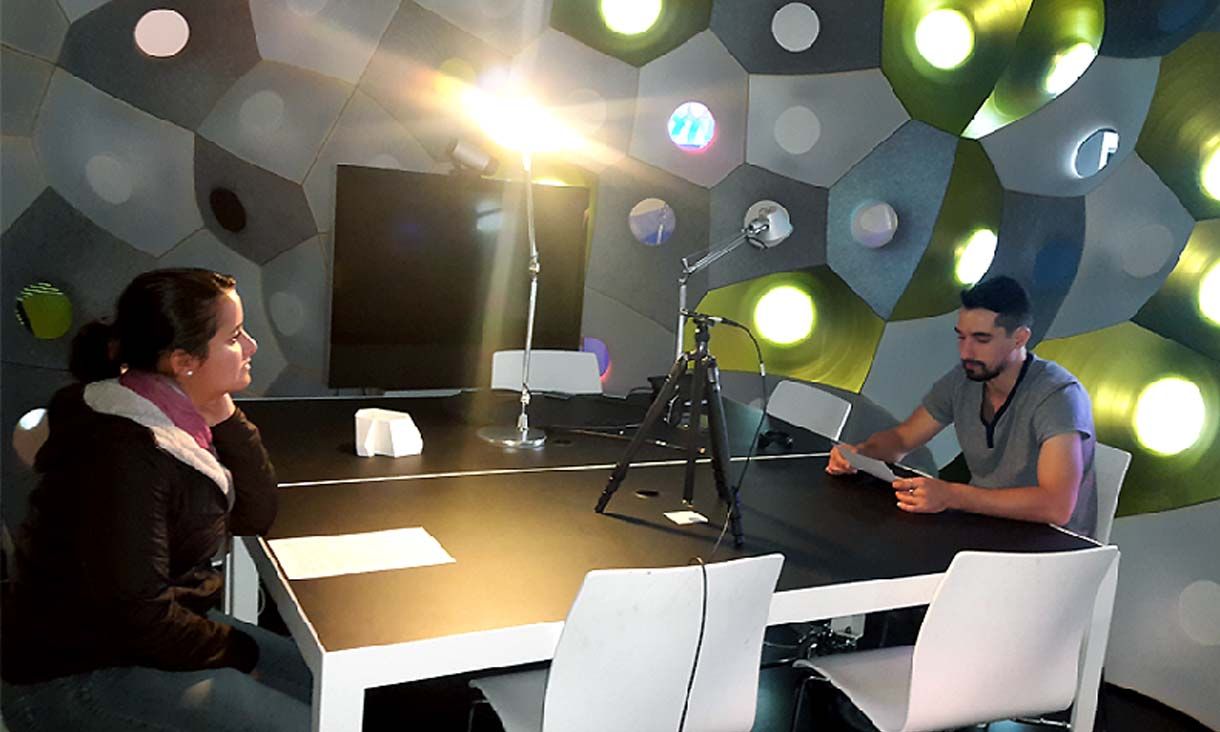Shaping sound in architectural spaces

Alambeigi’s research provides a set of geometric rules for architects to follow when they are in the initial stages of designing a sound-performative space. FabPod semi-enclosed meeting space, image copyright John Golling.
In summary
- Swinburne researcher Pantea Alambeigi has revealed new knowledge about the design of semi-enclosed meeting rooms and pods in open plan office spaces
- Her discoveries will influence the way meeting spaces are designed and constructed
- Alambeigi’s research reveals that the key to better speech privacy lies in geometry and provides a set of geometric rules for architects to follow in the initial stages of designing a sound-performative space
Swinburne researcher Pantea Alambeigi has revealed new knowledge about the design of semi-enclosed meeting rooms and pods in open plan office spaces. Her discoveries in the perception of human sound at work will influence the way meeting spaces are designed and constructed.
Shaping sound in novel office spaces
“My PhD research ‘Shape the Sound in Space: Design to Refine Speech Privacy Perception’ provides new knowledge for the design of semi-enclosed meeting rooms and pods in open plan offices, and discovery in the area of human sound perception, privacy, and the unconscious influences of the surrounding built environment on how we speak,” says Alambeigi.
In general, semi-enclosed spaces are not advised by sound specialists as acoustically there is no way to block the sound from propagating into open plan offices through the open ceiling.
The key is in geometry
Alambeigi’s research has revealed how geometry can successfully delay sound propagation in meeting room pod design. She has revealed that semi-enclosed meeting pods are capable of creating a micro-auditory environment within a larger space to accommodate the conflicting needs of speech privacy and speech intelligibility in a macro scale.

Recording sound propagation inside semi-enclosed FabPod, image by Pantea Alambeigi.

Recording sound propagation in sound booth, image by Pantea Alambeigi.
“My research demonstrates that there are geometrical solutions to achieving better speech privacy. These are available to architects and designers to apply in early design development stages. The key crucial factor in improving speech privacy in an open plan office, is the ability of specific geometry to hold sound inside a pod, before releasing it into the open plan environment,” says Alambeigi.

Preliminary (left) versus final design (right) iterations for FabPod ll by Canhui Chen.
Alambeigi’s research provides a set of geometric rules for architects with limited acoustic knowledge, to follow in the initial stages of designing a sound-performative space.
Commonly-used cubic pods or cocooning furniture constructions designed to be fully enclosed or widely open with acoustic materials to absorb the sound, fall short of taking this approach into account.
Making office acoustics easier on the ears? Sounds incredible
Alambeigi’s experimental research also uncovered the relationship between our vocal intensity and our experience of privacy within a space.
“Human perceptual interaction with the environment seems to play a major role in adapting vocal effort. The greater the sense of privacy, the less vocal effort and sound pressure level. This suggests a person’s perception of privacy and spatial impression are parameters that can unconsciously influence people’s speech pressure levels,” she says.
“This goes against the common assumption that workers in open plan offices speak with a lower voice level to ensure more privacy. Instead it indicates a lower perception of privacy is possibly conducive to higher speech level production. One potential underlying reason for this is the intuitive perception of sound propagation losses in open plan offices and semi-enclosed spaces, which exerts a force on the speaker to compensate by increasing the speech level without even being aware of it,” she explains.
-
Media Enquiries
Related articles
-

- Design
Swinburne alum launches zine celebrating Asian Australian art and identity
Swinburne Graphic Design alum Dan Truong founded HOISZN, a zine publication showcasing Asian Australian artists and their work.
Monday 01 July 2024 -

- Design
Swinburne students shine in lighting design collaboration
Swinburne students collaborated with About Space Lighting, resulting in several student-designed lamps being put into production.
Friday 07 June 2024 -

- University
Swinburne University of Technology partners with Grande Experiences and THE LUME Melbourne for cutting-edge Immersive Media education
Swinburne University of Technology is proud to announce its partnership with Grande Experiences and THE LUME Melbourne, enhancing the future of Immersive Media education.
Thursday 13 June 2024 -

- Design
Yarra Trams feature Women in Trades campaign designed by Swinburne students
School of Design and Architecture students in Swinburne’s Bureau collaborated with Tradeswomen Australia Group to design a tram wrap celebrating women in trades.
Thursday 16 May 2024 -

- Design
- Astronomy
- Technology
- University
Swinburne ‘Rock Muncher’ takes part in Australian Rover Challenge
A multidisciplinary student team from Swinburne University of Technology competed in the 2024 Australian Rover Challenge held in Adelaide, South Australia.
Thursday 11 April 2024

